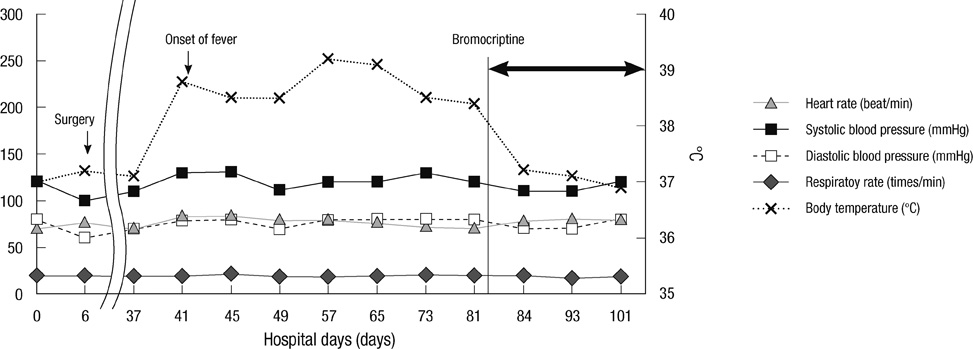J Korean Med Sci.
2012 Aug;27(8):965-968. 10.3346/jkms.2012.27.8.965.
Bromocriptine for Control of Hyperthermia in a Patient with Mixed Autonomic Hyperactivity after Neurosurgery: A Case Report
- Affiliations
-
- 1Division of Infectious Diseases, Department of Internal Medicine, Korea University College of Medicine, Seoul, Korea. young7912@korea.ac.kr
- 2Department of Neurosurgery, Hallym University College of Medicine, Anyang, Korea.
- KMID: 1714213
- DOI: http://doi.org/10.3346/jkms.2012.27.8.965
Abstract
- Mixed autonomic hyperactivity disorder (MAHD) among patients with acquired brain injury can be rare. A delayed diagnosis of MAHD might exacerbate the clinical outcome and increase healthcare expenses with unnecessary testing. However, MAHD is still an underrecognized and evolving disease entity. A 25-yr-old woman was admitted the clinic due to craniopharyngioma. After an extensive tumor resection, she complained of sustained fever, papillary contraction, hiccup, lacrimation, and sighing. An extensive evaluation of the sustained fever was conducted. Finally, the cause for MAHD was suspected, and the patient was successfully treated with bromocriptine for a month.
MeSH Terms
-
Adult
Brain/radionuclide imaging
Bromocriptine/*therapeutic use
Craniopharyngioma/complications/diagnosis/surgery
Female
Fever/complications/*drug therapy
Hormone Antagonists/*therapeutic use
Humans
Hyperkinesis/complications/*diagnosis
Magnetic Resonance Imaging
Neurosurgical Procedures/*adverse effects
Pituitary Neoplasms/complications/diagnosis/surgery
Tomography, X-Ray Computed
Hormone Antagonists
Bromocriptine
Figure
Reference
-
1. Penfiel W. Diencephalic autonomic epilepsy. Arch Neurol Psychiatry. 1929. 22:358–374.2. Rabinstein AA. Paroxysmal sympathetic hyperactivity in the neurological intensive care unit. Neurol Res. 2007. 29:680–682.3. Boeve BF, Wijdicks EF, Benarroch EE, Schmidt KD. Paroxysmal sympathetic storms ("diencephalic seizures") after severe diffuse axonal head injury. Mayo Clin Proc. 1998. 73:148–152.4. Fox RH, Wilkins DC, Bell JA, Bradley RD, Browse NL, Cranston WI, Foley TH, Gilby ED, Hebden A, Jenkins BS, et al. Spontaneous periodic hypothermia: diencephalic epilepsy. Br Med J. 1973. 2:693–695.5. Giroud M, Sautreaux JL, Thierry A, Dumas R. Diencephalic epilepsy with congenital suprasellar arachnoid cyst in an infant. Childs Nerv Syst. 1988. 4:252–254.6. Perkes I, Baguley IJ, Nott MT, Menon DK. A review of paroxysmal sympathetichyperactivity after acquired brain injury. Ann Neurol. 2010. 68:126–135.7. Fernández-Ortega JF, Prieto-Palomino MA, Muñoz-López A, Lebron-Gallardo M, Cabrera-Ortiz H, Quesada-García G. Prognostic influence and computed tomography findings in dysautonomic crises after traumatic brain injury. J Trauma. 2006. 61:1129–1133.8. Baguley IJ, Nicholls JL, Felmingham KL, Crooks J, Gurka JA, Wade LD. Dysautonomia after traumatic brain injury: a forgotten syndrome? J Neurol Neurosurg Psychiatry. 1999. 67:39–43.9. Commichau C, Scarmeas N, Mayer SA. Risk factors for fever in the neurologic intensive care unit. Neurology. 2003. 60:837–841.10. Kilpatrick MM, Lowry DW, Firlik AD, Yonas H, Marion DW. Hyperthermia in the neurosurgical intensive care unit. Neurosurgery. 2000. 47:850–855.11. Stocchetti N, Rossi S, Zanier ER, Colombo A, Beretta L, Citerio G. Pyrexia in head-injured patients admitted to intensive care. Intensive Care Med. 2002. 28:1555–1562.12. Rabinstein AA, Sandhu K. Non-infectious fever in the neurological intensive care unit: incidence, causes and predictors. J Neurol Neurosurg Psychiatry. 2007. 78:1278–1280.13. von Wild KR. Hannover, Münster TBI Study Council. Posttraumatic rehabilitation and one year outcome following acute traumatic brain injury (TBI): data from the well defined population based German Prospective Study 2000-2002. Acta Neurochir Suppl. 2008. 101:55–60.14. Baguley IJ. Autonomic complications following central nervous system injury. Semin Neurol. 2008. 28:716–725.15. Benarroch EE. The central autonomic network: functional organization, dysfunction, and perspective. Mayo Clin Proc. 1993. 68:988–1001.16. Blackman JA, Patrick PD, Buck ML, Rust RS Jr. Paroxysmal autonomic instability with dystonia after brain injury. Arch Neurol. 2004. 61:321–328.17. Bullard DE. Diencephalic seizures: responsiveness to bromocriptine and morphine. Ann Neurol. 1987. 21:609–611.18. Rossitch E Jr, Bullard DE. The autonomic dysfunction syndrome: aetiology and treatment. Br J Neurosurg. 1988. 2:471–478.19. Russo RN, O'Flaherty S. Bromocriptine for the management of autonomic dysfunction after severe traumatic brain injury. J Paediatr Child Health. 2000. 36:283–285.
- Full Text Links
- Actions
-
Cited
- CITED
-
- Close
- Share
- Similar articles
-
- Central Hyperthemia Treated with Bromocriptine in a Patient with Aquaporin 4 Antibody Positive Neuromyelitis Optica Spectrum Disorder
- A Case of Hyperprolactinemia Treated by Vaginal Bromocriptine Administration
- Preoperative Bromocriptine Treatment of the Large Pituitary Adenoma
- Akinetic Mutism from Obstructive Hydrocephalus;Successful Treatment with Bromocriptine and Ephedrine
- Autonomic Dysfunction after Traumatic Brain Injury




